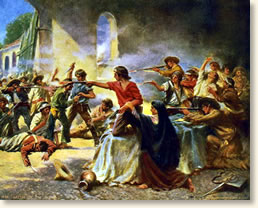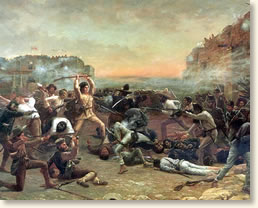In 1835, a general uprising throughout Mexico sought to overthrow the dictatorial reign of President Antonio Lopez de Santa Anna. American citizens who had settled in the Mexican province of Texas joined the uprising and successfully forced the Mexican military across the Rio Grande River. The objective of these Texan revolutionaries soon changed from modifying the dictatorial rule of General Santa Anna to establishing an independent state of Texas.
 A fight to the death at the Alamo |
Arriving on February 23, 1836, Santa Anna’s troops surrounded the Alamo, laying siege to its defenders. The Mexican Army began to bombard the former mission with cannon shot in an effort to systematically reduce its protective walls to rubble. The assault began in earnest during the early morning hours of March 6 as Mexican soldiers swarmed the walls of the fortress. The Alamo defenders successfully repulsed two attacks but were overwhelmed by the third. The combat was characterized by room-to-room fighting in which all but a handful of the defenders were killed. The ferocity of their defense is underscored by the fact that it resulted in the death of an estimated 600 Mexicans.
"Remember the Alamo!" became a rallying cry that swelled the ranks of the Texian Army led by General Sam Houston. On April 21, this force attacked the Mexican army at the Battle of San Jacinto, captured General Santa Anna and forced him to lead his troops back across the Rio Grande. The independence of Texas was assured.
"At last they were all destroyed by grape, musket shot and the bayonet."
The following account is provided by a member of Santa Anna's army that besieged the Alamo. We join his story on the evening just before the attack:
"On this same evening, a little before nightfall, it is said that Barret Travis, commander of the enemy, had offered to the general-in-chief, by a woman messenger, to surrender his arms and the fort with all the materials upon the sole condition that his own life and the lives of his men be spared. But the answer was that they must surrender at discretion, without any guarantee, even of life, which traitors did not deserve. It is evident, that after such an answer, they all prepared to sell their lives as dearly as possible. Consequently, they exercised the greatest vigilance day and night to avoid surprise.
On the morning of March 6, the Mexican troops were stationed at 4 o'clock, A.M., in accord with Santa Anna's instructions. The artillery, as appears from these same instructions, was to remain inactive, as it received no order; and furthermore, darkness and the disposition made of the troops which were to attack the four fronts at the same time, prevented its firing without mowing down our own ranks. Thus the enemy was not to suffer from our artillery during the attack. Their own artillery was in readiness. At the sound of the bugle they could no longer doubt that the time had come for them to conquer or to die. Had they still doubted, the imprudent shouts for Santa Anna given by our columns of attack must have opened their eyes.
As soon as our troops were in sight, a shower of grape and musket balls was poured upon them from the fort, the garrison of which at the sound of the bugle, had rushed to arms and to their posts. The three columns that attacked the west, the north, and the east fronts, fell back, or rather, wavered at the first discharge from the enemy, but the example and the efforts of the officers soon caused them to return to the attack. The columns of the western and eastern attacks, meeting with some difficulties in reaching the tops of the small houses which formed the walls of the fort, did, by a simultaneous movement to the right and to left, swing northward till the three columns formed one dense mass, which under the guidance of their officers, endeavored to climb the parapet on that side.
 The Death of Davy Crockett |
This obstacle was at length overcome, the gallant General Juan V Amador being among the foremost. Meantime the column attacking the southern front under Colonels Jose Vicente Minon and Jose Morales, availing themselves of a shelter, formed by some stone houses near the western salient of that front, boldly took the guns defending it, and penetrated through the embrasures into the square formed by the barracks. There they assisted General Amador, who having captured the enemy's pieces turned them against the doors of the interior houses where the rebels had sought shelter, and from which they fired upon our men in the act of jumping down onto the square or court of the fort. At last they were all destroyed by grape, musket shot and the bayonet.
Our loss was very heavy. Colonel Francisco Duque was mortally wounded at the very beginning, as he lay dying on the ground where he was being trampled by his own men, he still ordered them on to the slaughter. This attack was extremely injudicious and in opposition to military rules, for our own men were exposed not only to the fire of the enemy but also to that of our own columns attacking the other fronts; and our soldiers being formed in close columns, all shots that were aimed too low, struck the backs of our foremost men. The greatest number of our casualties took place in that manner; it may even be affirmed that not one fourth of our wounded were struck by the enemy's fire, because their cannon, owing to their elevated position, could not be sufficiently lowered to injure our troops after they had reached the foot of the walls. Nor could the defenders use their muskets with accuracy, because the wall having no inner banquette, they had, in order to deliver their fire, to stand on top where they could not live one second.
The official list of casualties, made by General Juan de Andrade, shows: officers 8 killed, 18 wounded; enlisted men 52 killed, 233 wounded. Total 311 killed and wounded. A great many of the wounded died for want of medical attention, beds, shelter, and surgical instruments.
The whole garrison were [sic] killed except an old woman and a negro slave for whom the soldiers felt compassion, knowing that they had remained from compulsion alone. There were 150 volunteers, 32 citizens of Gonzales who had introduced themselves into the fort the night previous to the storming, and about 20 citizens or merchants
The History of The Alamo: A timeline

- 1718—Mission San Antonio de Valero is established by Franciscan priests from Spain along San Pedro Creek, then moved in 1719 to a location south of the Alamo’s present location.
- 1724—Spanish officials move the mission to its present site following destruction by a storm. Construction of the Long Barrack begins, with completion in 1744.
- 1744—Construction begins for the mission’s church.
- 1756—The church’s walls collapse.
- 1762—Construction work ends at the mission before the roof is complete. The roof arches and bell tower fall.
- 1793—Spanish authorities announce secularization of the five Spanish missions in San Antonio, granting local control of the churches and mission lands.
- 1803-1835—The Alamo is occupied by Mexican troops, including a company of Spanish soldiers from Álamo de Parras, Coahuila, Mexico. The name “Alamo” may come from these soldiers, or perhaps from a grove of cottonwood (“alamo” in Spanish) trees along the bank of the San Antonio River.
- 1836—Texians occupy the mission as a fortress during the Battle of the Alamo.
- 1841—Republic of Texas returns the church to the Catholic Church.
 1850—The U.S. government leases the Alamo from the Catholic Church, and the U.S. Army begins repairing the mission, adding a gabled roof and the distinctive curved facade.
1850—The U.S. government leases the Alamo from the Catholic Church, and the U.S. Army begins repairing the mission, adding a gabled roof and the distinctive curved facade.
- 1883—Texas purchases the property from the Catholic Church.
- 1905—Texas passes legislation turning custody of the Alamo church and buildings to the Daughters of the Republic of Texas, who begin restoration.
- 2011—Texas General Land Office is given custody of the Alamo, with the Daughters of the Republic of Texas being responsible for daily operations under a state contract.
The Texas Revolution
- 1824—The Mexican government adopts the Federal Constitution of 1824 and establishes the state of Coahuila y Texas, which the Texians feel do not represent their interests. Catholicism was proclaimed the state religion and slavery was forbidden. Immigrants who had come to Texas from the United States protest, although their efforts were not successful.
- 1830—To prevent further rebellion, Mexico passes a law in 1830 that bans Americans from moving to Texas.
- 1832—The first skirmish between the settlers in Texas and Mexican authority breaks out in Anahuac on the Texas coast.
- 1833—Mexican General Antonio Lopez de Santa Anna is elected president of Mexico. In 1834, he disbands the Mexican Congress in a move toward dictatorship.
- 1833—Texas petitions Mexico for statehood, asking for separation from Coahuila, with Stephen F. Austin carrying a petition to Mexico City. Austin is arrested and jailed for a year and a half.
- S
 eptember, 1835—Mexican General Martín Perfecto de Cós arrives in the port at Copano, 30 miles north of Corpus Christi, with 500 troops on their way to San Antonio.
eptember, 1835—Mexican General Martín Perfecto de Cós arrives in the port at Copano, 30 miles north of Corpus Christi, with 500 troops on their way to San Antonio.
- October 1, 1835—The Battle of Gonzales takes place with Gonzales residents refusing to give up their cannon to the Mexican army, causing the Mexican troops to retreat. The War of Texas Independence begins.
- October 9, 1835—The Battle of Goliad results in victory for the Texians.
- October 28, 1835—Despite being outnumbered 3 to 1, the Texians defeat General Cós and his men at the Battle of Concepción.
- December 5, 1835—The Siege of Bexar takes place, involving days of fighting between General Cós’s Mexican troops and the Texians, ending with the surrender of Cós on December 9.
- January 7, 1836—Santa Anna’s troops arrive in Saltillo to begin their march to San Antonio to reclaim the city.
The Battle of the Alamo
- January 19, 1836—Colonel James Bowie arrives to investigate the military situation for Texas Governor Henry Smith and General Sam Houston.
- February 2, 1836—Bowie and Lt. Col. James Clinton Neill, commander of the Texian garrison, vow "we will rather die in these ditches than give it up to the enemy." Lieutenant Colonel William B. Travis arrives with 30 men.
- February 8, 1836—Former U.S. Congressman and famous frontiersman David Crockett from Tennessee arrives in San Antonio de Béxar with 12 volunteers.
- February 14, 1836—Travis and Bowie agree to share command at San Antonio de Béxar after Colonel Neill received a temporary leave of absence.
 February 23, 1836—Antonio López de Santa Anna and the Centralist forces arrive and the Siege of the Alamo begins.
February 23, 1836—Antonio López de Santa Anna and the Centralist forces arrive and the Siege of the Alamo begins.
- February 24, 1836—Travis wrote his famous letter to "the people of Texas and all Americans of the world" requesting reinforcements. In the coming days, there were several more requests by Travis for reinforcements.
- March 5, 1836—Travis reportedly drew a line in the sand and gave every man the choice to cross the line and join him in a fight to the death to defend the Alamo. All but one man crossed.
- March 6, 1836—The Alamo falls. In a matter of hours, all the American defenders were killed and the Mexicans claimed the victory.










So great to finally meet you folks! That last photo is a goody!! Grace (in Tucson)
ReplyDelete